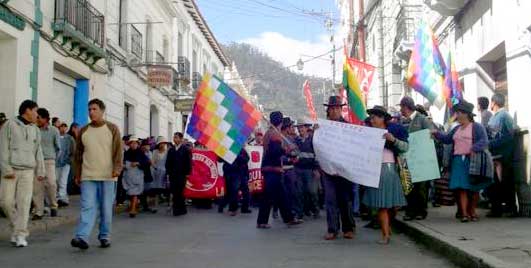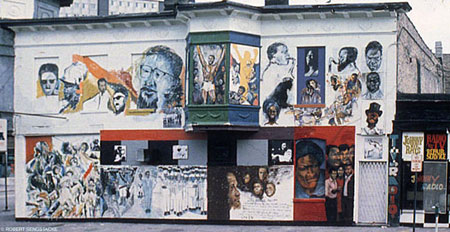Found 4305 matches from 1,400 records in about 0.1491 seconds for phone or e or geodeta.
“The latest Sober variant is one of a relatively new type of ‘propaganda spam,’ meant to spread political messages rather than sell a product or service. Circulation of the worm coincides with ceremonies marking the 60th anniversary of the end of World War II in Europe and examples of subject lines it sends include ‘Dresden 1945’ and ‘Du wirst zum Sklaven gemacht!!!’ (‘You are made slaves!!!’).
We are updating our spam filter.”

On May 27, a group of concerned citizens hijacked a million dollar Leo Burnett ad campaign designed for the Chicago Housing Authority, turning it into a scathing critique of Chicago’s public housing policy and privatization practices.
They created and changed out over a dozen large format bus shelter ads (5 in downtown Chicago in broad daylight!), put up thousands of ads on the trains, printed a newspaper of information and reproductions of the flipped ads, and created a mock Web site for the Chicago Housing Authority in the style of the official site.



See the old ads, download the new ads, and find out more about the campaign at ChicagoHousingAuthority.net:
“In late 2004, the Chicago Housing Authority (CHA) initiated a public relations campaign to put a new face on their Plan for Transformation, a plan that drastically reshapes the state of public housing in Chicago.
This PR campaign, authored by the advertising giant Leo Burnett, fused Chicago Housing Authority's acronym ‘CHA’ with the word ‘change’, resulting in a new brand identity: CHAnge. There are undoubtedly big changes happening with public housing in Chicago, including massive organizational restructuring within CHA and the tearing down of all high-rise public housing buildings.
Unfortunately, the priorities of CHA haven’t changed at all, and public housing residents are still at the bottom of the list. While the CHAnge campaign has attempted to put a ‘resident empowerment’ spin on the Plan for Transformation, in reality the majority of public housing residents have been adversely affected by the massive restructuring. If you are a single working mother displaced by a home demolition, waiting over 6 months for a voucher to relocate as your children are shifted from school to school, CHAnge feels a lot more like CHAos....
The Plan for Transformation is a $1.6 billion blueprint that includes the demolition of 14,000 public housing units and the displacement of over 20,000 people. Not unlike the ‘urban renewal’ master plans of previous decades, the Plan For Transformation has linked motives. It is pushing poor people out of the now-coveted inner city neighborhoods and increasing the exchange value of existing public land through privatization. Developers such as Dan McLean are making millions building on the land adjacent to former CHA high-rises and getting huge city tax credits to subsidize their development. In addition, the city is making money by selling or leasing former CHA public land to private developers. In this way, large amounts of our city’s housing budget are being transferred into private hands. CHA CEO Terry Peterson was personally implicated in this when he was caught giving CHA bids to contractors like the Habitat Group in exchange for political contributions.”

The Wall of Respect was an outdoor mural created in 1967 on the South Side of Chicago by a group of visual artists from the Organization of Black American Culture. It was a time when African Americans were virtually absent from the mainstream media. The initial theme of the mural was ‘Black Heros.’ Some sections of the Wall were later repainted by artists with scenes that responded to current events in the Civil Rights Movement.
As a focal point within its community, the Wall became a catalyst of the redevelopment of Chicago’s South Side and of the Black Power Movement. It became a place to meet and rally, notably of two large gatherings: the August 1967 rally organized by the Student Nonviolent Coordinating Committee and the October 1967 “black festival of creativity” organized by the 43rd Street Community Organization.
The Wall quickly drew national attention and inspired the Community Mural Movement. The Wall inspired black pride murals in Detroit, Boston, St. Louis, and Philadelphia, as well as Latino/a and Asian American community murals.
It also drew the attention of the FBI’s COINTELPRO which sent anonymous threats to the Organization of Black American Culture and participating artists. The organization disbanded shortly after the completion of the wall.
In 1971, the building was damaged by fire and subsequently demolished.
Northwestern’s Wall of Respect Web site features photos and essays about the Wall, Quicktime interviews, lesson plans, and poems about the Wall by Gwendolyn Brooks and Don L. Lee.
The Wiphala (from the Aymara word meaning “flag”) is a square shaped flag consisting of forty-nine small squares in a seven by seven grid, in the colors of the rainbow graduating from the brightest to the palest.
The flag is a symbol of the Aymara people, and recently, of the Aymara uprising in Bolivia. It has also become a symbol in the broader iconography of pro-indigenous movements in Ecuador, Peru, Bolivia, and Chile.
The origin of the design is uncertain. It is attributed the ancient Tiwanaku state. However, despite the indigenous aesthetic resonances of the unusual square pattern and multicolor geometry, it is most likely of modern origin. Although pre-Columbian towns of the Andes did not lack their own symbols (particularly those with a state tradition, like the Inca), the format of quadrilateral textile banner to wave in the wind is a tradition of the Old World.
Archaeological fragments from antiquity support the thesis that it may a “rescued” old symbol, as with the Chakana or Andean cross. It is possible that the modern origin of the Wiphala (without discarding the hypothesis of its Tiwanaku roots) is related to the design of modern flag of the Cusco (rectangular with seven horizontal strips with the colors of rainbow), which many claim to be a flag of the Incas.
Rainbow patterns were used in several symbols of the Tiwanaku state, but it is not documented in the form of a flag — while other formats of indigenous state symbols have been found.
 However, Aymara textile read as a symbol is not completely unheard of. In 1534, during the Spanish invasion and occupation of Cuzcu, the Spaniards found among the resistance a multitude of objects similar to the striped flag and and other iconography with the of seven colors of the rainbow. The Wiphala was banned, considered politically subversive by the governing elite.
However, Aymara textile read as a symbol is not completely unheard of. In 1534, during the Spanish invasion and occupation of Cuzcu, the Spaniards found among the resistance a multitude of objects similar to the striped flag and and other iconography with the of seven colors of the rainbow. The Wiphala was banned, considered politically subversive by the governing elite.
The great explosion in the use of the Wiphala coincides with the rural mobilizations and indigenous movements in Bolivia in the 1970’s. It has since become a recognizable Amerindian symbol in the political struggles of the indigenous nations of the American continent. In Bolivia, the Wiphala is visible in all kinds of public demonstrations, political actions, and civil resistance by the Aymara and Quechua population.
Civic use of the Wiphala in the daily life of indigenous communities has also grown enormously. It has become an Andean custom to hoist the flag at social and cultural events, ceremonies, and celebrations.

Christopher DeWolf has a nice little editorial on posters and the political struggles around them in a couple of Canadian cities:
“Posters are the city. For community groups, musicians, activists, small businesses, and hell, even people who’ve lost their cat, they’re often the only way to get a message out. They cover lampposts, service doors, construction hoardings and blank walls, livening up grey and depressing winters and turning underused spaces into interactive bulletin boards where the city’s goings-on are announced to anyone who might be interested. Despite their importance to civic and cultural life however, posters are an all-too-easy target for municipal politicians and bureaucrats who want their city streets as bland and orderly as a Lego metropolis. Posters might seem innocuous, but they are in fact a sign of a city’s vitality and diversity — how municipalities deal with postering is a measure of just how willing they are to accommodate that vibrancy.”
DeWolf privileges “freedom of expression” and a “diversity” of voices but I would take it further and say that this is a matter of democracy itself — of ownership of the means of communication and the of the physical space of our communities, of building community and political power.
Via Visual Resistence I found this call for entries:
“SAW (Street Art Workers) is seeking posters for an international street art campaign about land and the effects of globalization. We want you to design and submit posters that will be printed and wheatpasted in cities across Europe and North America. The strongest designs will be published as a mass produced, newsprint poster collection. This will be a 24 page, 2-color newspaper which will include up to 30 posters. SAW will pay for the printing, and volunteers will distribute the posters. The majority of posters will be wheatpasted in public by participating artists and folks who just want to paste up their city.
Based in the U.S., SAW is a network of printmakers, stencil artists, graffiti writers and painters who use the streets for art and activism. We are taking back our cities and towns from the businessmen, cops and politicians who define public space for their own benefit. As a volunteer-run group, we make street art for political campaigns and post each other’s work across North America. Since 2001, our projects have talked about prisons, the mass media and utopian ideas for the future.
We want posters that build connections between international struggles and actual organized projects with high profile publicity. We especially want to see multilingual submissions and work from the perspective of women, Third World communities and indigenous/First Nations. We suggest that artists collaborate with grassroots, social change organizations of their choosing to make posters. We want posters that are both imaginative and relevant to “on the ground” organizing around issues of land, housing and globalization. Working with an organization is not required, but it is encouraged.
It could be argued that Christopher Columbus began our current age of globalization when he washed up on the shores of the New World. The slave trade, imperialism and resource theft that followed in Asia, Africa and America were a brutal beginning for globalization. Today imperial conquest has been refined into cold, impersonal corporate bureaucracies. In the last 30 years these corporations have become economic giants more powerful than many countries. Setting up global assembly lines, today’s corporations move freely around the world forcing countries, rich and poor, to surrender their land, resources and labor. In the process, corporations have made massive profits shifting wealth from the global south to the industrialized north, from the impoverished and working people to the rich and powerful.
SAW wants to look at how this form of globalization has affected our lands and how people are fighting back. How has it affected land in the cities — especially housing? How has globalization impacted land and workers in the countryside with farming, mining, drilling, logging and other resource extraction? What are the connections between land struggles in the global south, indigenous nations and the industrialized north? What are some of the connections between the landless peasants movement of Brazil and the squatter movements of Europe and North America? What links together the struggle against dams in India, hydroelectric projects Canada and water privatization in Latin America and South Africa? How are farmers and campesinos resisting industrial agriculture, like biotechnology and GMOs (genetically modified foods), in the U.S., Mexico and India? What organizing strategies have worked and hich ones have failed? These questions are a starting point. We want to see more questions from you and some hard-hitting answers. We want powerful ideas and inspirational art that we can broadcast directly to the streets in 2005.”
The deadline for submissions is September 1, 2005.
For more info, visit streetartworkers.org
From an interview with Dan Bar-On, co-founder of the Peace Research Institute in the Middle East:
“
One of our projects is to develop a new school textbook with a group of Palestinian teachers and Israeli teachers and two historians. We suggested that they take some dates from the history of the conflict... there were three dates: 1917, the Balfour Declaration, 1948, and the First Intifada. Each teacher should write his own narrative about these dates. Then they read each other’s narratives, they commented on them, and they asked questions. Finally, they were written up as two separate narratives. The task of the teacher is to teach both narratives to the pupils, and thereby to make the pupils aware, and to respect and acknowledge the fact that there are different narratives, that it’s not one legitimate and one not, and not that one are facts and one are propaganda, like the public says. These are two different perspectives, two different understandings of what happened in the history of the conflict.”
The book itself is a physical model of the divide — one half tells the Israeli story, flip it over and the other half tells the Palestinian story, with blank pages between the two.
 As the UK evaluates its waste reduction programs, five BBC correspondents file a nice little collection of vignettes on the state of waste reduction and recycling around the world.
As the UK evaluates its waste reduction programs, five BBC correspondents file a nice little collection of vignettes on the state of waste reduction and recycling around the world.
Of note is Switzerland’s garbage tax sticker:
“The Swiss do not recycle just because they care about the environment. There is a strong financial incentive. Recycling is free, but in most parts of Switzerland throwing away rubbish costs money — each rubbish bag has to have a sticker on it, and each sticker costs at least one euro (60 pence).
So the less you throw out, the less you pay. No sticker? Then the rubbish will be left outside your house to rot.”
The snapshots are all too brief (and a little more anecdote than analysis) but leave me hungry for more.
.....
June 29, 2005 — Reader Jim R. writes:
“Being a country of ‘participative democracy’ in almost the extreme sense of the word, the Swiss get to vote, a few times a year, on many topics both of great and little significance. The federal government leaves the cantons with a lot of power. One thing the cantons can vote on is how they want to handle garbage collection. Last year sometime we had an initiative on Gebührensäcke.
I live in canton Vaud, and at the time garbage collection was paid for out of our local taxes. We voted as to whether we should switch to paying more for garbage bags (in lieu of a sticker), which would cover at least some of the costs of garbage collection. The initiative failed. The two main arguments against were:
1. Certain costs should be shared equally by everyone, regardless of family situation. Therefore a single person should pay (roughly) the same for garbage as a family. Swiss Socialist tendencies, perhaps?
2. Opponents warned of "garbage tourism" where people would drop their garbage bags over the border in the next canton.
A trickster might just drop off his garbage bag somewhere along the road late at night. But beware: Sometimes the authorities will go through the garbage, looking for an address or something else that will incriminate the perpetrator. But I think that happens more in the German part than here in the French part.
Yes, the Swiss are pretty damn good at recycling compared to other countries in Europe. And let’s not even talk about the States... But there’s still plenty of room for improvement here.”
Just flipping through Teaching Graphic Design, another compilation edited by Steven Heller.
The book consists of sample curricula, “Course Offerings and Class Projects from the Leading Undergraduate and Graduate Programs” in graphic design and typography, professional practice, exhibition, and Web design.
Notably absent is much mention of social responsibility. Only one chapter by Stewart Ewan attempts to do so explicitly (with projects on designing flags... and currency. Blah.) Another assignment asks students to design a poster “about human rights.” But to what ends?
This absence of any actual public engagement is particularly striking because Heller’s previous volume, Citizen Designer: Perspectives on Design Responsibility repeatedly and specifically fingers design education as the place where designers go astray and the reason designers are not more socially engaged.
Well, so much for that.
It raises the question, though, of what a book of progressive design curricula would look like.
A little Paolo Freire? A little Augusto Boal? I imagine something written not just for design teachers, but for a broader audience. It might touch on:
- Using design research and problem solving methodolgy to address civic issues
- Designing visual tools for public participation
- Reading assumptions encoded in images, structures, and practices
- Design for community building and advocacy
- Using design to streamline civic processes
- Issues on sustainable design and responsible printing
- Methods of user testing
- Multi-lingual design
It would cover media including:
- Basic typography
- Information design
- Documentary or narrative design
- Posters, graffiti, and street art
- Transportation graphics and civic way finding
- Mapping
- Branding and communications design
- Design for multimedia
It would integrate principles of cost-effectiveness, accessibility and inclusiveness, usability, environmental sensitivity, and technologically appropriate solutions.
Too much for undergrads? Why not throw in some historical analysis of art, design and social movements? An analysis of strategy and tactics... I could go on.
Any takers? Done properly, such book might be useful for grassroots groups and social movements, too. I’m sure there’s grant money to be had.

It’s a funny thing to see all the flag waving conflated with the whole “support the troops” message today. I support the troops plenty, though not this stupid war. But then what exactly do the troops have to do with the fourth of July? I mean, today is Independence Day! The day we celebrate the American Revolution, when a plucky, unorganized group of armed radicals defeated the professional military of a foreign occupation. A victory for automony over empire! In Iraq, aren’t the U.S. troops a lot closer ye olde army of King George?
page 1 2 3 4 5 6 7 8 9 10 11 12 13 14 15 16 17 18 19 20 21 22 23 24 25 26 27 28 29 30 31 32 33 34 35 36 37 38 39 40 41 42 43 44 45 46 47 48 49 50 51 52 53 54 55 56 57 58 59 60 61 62 63 64 65 66 67 68 69 70 71 72 73 74 75 76 77 78 79 80 81 82 83 84 85 86 87 88 89 90 91 92 93 94 95 96 97 98 99 100 101 102 103 104 105 106 107 108 109 110 111 112 113 114 115 116 117 118 119 120 121 122 123 124 125 126 127 128 129 130 131 132 133 134 135 136 137 138 139 140 141 142 143 144 145 146 147 148 149 150 151 152 153 154 155 156 157 158 159 160 161 162 163 164 165 166 167 168 169 170 171 172 173 174 175 176 177 178 179 180 181 182 183 184 185 186 187 188 189 190 191 192 193 194 195 196 197 198 199 200 201 202 203 204 205 206 207 208 209 210 211 212 213 214 215 216 217 218 219 220 221 222 223 224 225 226 227 228 229 230 231 232 233 234 235 236 237 238 239 240 241 242 243 244 245 246 247 248 249 250 251 252 253 254 255 256 257 258 259 260 261 262 263 264 265 266 267 268 269 270 271 272 273 274 275 276 277 278 279 280 281 282 283 284 285 286 287 288 289 290 291 292 293 294 295 296 297 298 299 300 301 302 303 304 305 306 307 308 309 310 311 312 313 314 315 316 317 318 319 320 321 322 323 324 325 326 327 328 329 330 331 332 333 334 335 336 337 338 339 340 341 342 343 344 345 346 347 348 349 350 351 352 353 354 355 356 357 358 359 360 361 362 363 364 365 366 367 368 369 370 371 372 373 374 375 376 377 378 379 380 381 382 383 384 385 386 387 388 389 390 391 392 393 394 395 396 397 398 399 400 401 402 403 404 405 406 407 408 409 410 411 412 413 414 415 416 417 418 419 420 421 422 423 424 425 426 427 428 429 430 431
[ Back ]
[ Next ]


